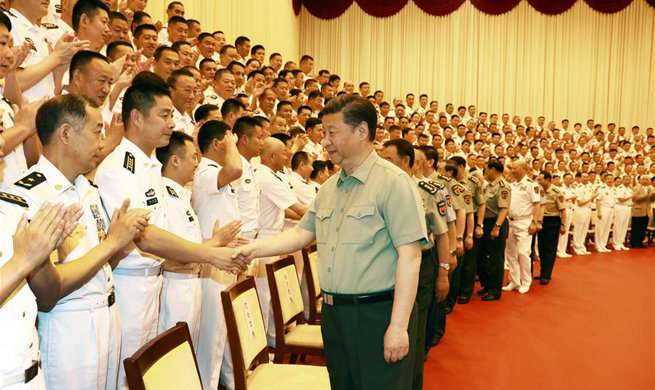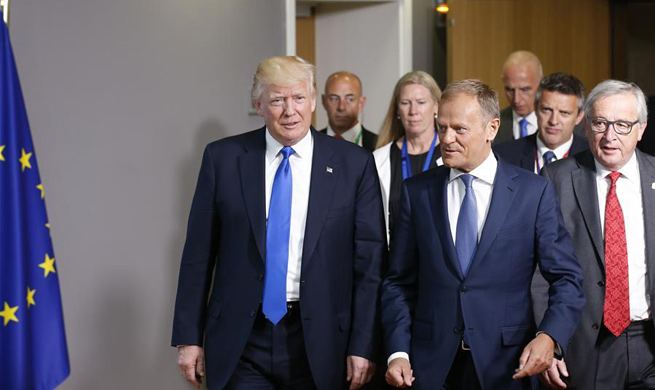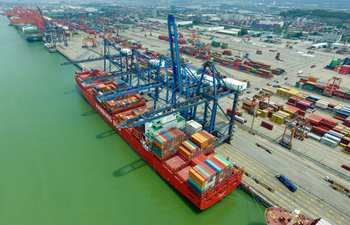
File photo taken on Nov. 23, 2016 shows the national flags of the United States and China during the 27th Session of the China-U.S. Joint Commission on Commerce and Trade (JCCT) in Washington D.C., capital of the United States. (Xinhua/Yin Bogu)
BEIJING, May 25 (Xinhua) -- China is willing to work with the United States to realize balanced development of trade and investment, a research report by the Ministry of Commerce (MOC) said Thursday.
"Looking into the future, China is willing to make joint efforts with the United States to encourage Chinese enterprises to participate in U.S. infrastructure construction, further open up markets, promote two-way investment and advance bilateral investment treaty negotiations to further strengthen China-U.S. trade and economic cooperation at local levels," said the Research Report on China-U.S. Economic and Trade Relations.
China will also consider increasing imports from the United States in agricultural products, energy, high-tech products and services, to increase the total benefits while realizing a balanced development of trade and investment, according to the report.
Both China and the United States benefit from trade and economic cooperation. China has maintained a trade surplus in goods, but the United States has also gained tangible benefits.
China is the U.S. largest export market outside North America, and an important export destination for soybeans, cotton, aircraft, automobiles and integrated circuits. In 2016, the United States had a trade surplus in agricultural products of 16.4 billion U.S. dollars.
Over the past 10 years, the average growth rate of U.S. exports to China was nearly three times the growth rate of U.S. exports as a whole, and twice the growth rate of China's exports to the United States.
The United States has maintained a long-term surplus in service trade. In 2016, it exported 51 movies to China, receiving revenue of 16 billion U.S. dollars. Chinese tourists and students in the United States spent more than 51 billion U.S. dollars.
With respect to investment, U.S.-funded enterprises in China have maintained good performance and gained high profits. Sales revenue in 2015 totaled 517 billion U.S. dollars, and profit reached 36.2 billion U.S. dollars.
Investment from Chinese enterprises in the United States is growing rapidly. Chinese investment projects have taken place in 46 states and 425 congressional districts, creating over 140,000 local jobs.
According to the U.S.-China Business Council, in 2015, U.S. exports to China and China-U.S. two-way investment contributed 216 billion U.S. dollars to the U.S. GDP, and supported 2.6 million local jobs.
China has made relentless efforts in recent years to balance China-U.S. economic and trade relations, the report said.
China has frequently dispatched trade and investment delegations to participate in trade and investment promotion activities in the United States. In February 2012 and September 2015, two large Chinese delegations visited the United States and signed trade, investment and cooperation agreements across all sectors, totaling about 44 billion U.S. dollars.
China has been addressing the specific concerns of the U.S. enterprises through the China-U.S. Joint Commission on Commerce and Trade. Since 2004, the two sides have strengthened policy communications through dialogue and consultation and great progress has been made in several areas, including antitrust law enforcement procedures, exports of agricultural products to China, software legalization, and access to China Compulsory Certification (3C) services of foreign-funded enterprises.
Moreover, China has been vigorously promoting trade and economic cooperation between Chinese and U.S. cities, and has been actively building exhibition platforms to expand imports from the United States.
The report called on the United States to give China fair treatment in export and investment issues.
The United States has exercised strict control over high-tech exports to China while criticizing China for encouraging independent innovation, an apparent paradox, according to the report.
The U.S. export control is based on a Cold War mentality, ignoring the rapid development of bilateral ties and not fitting to its future development, the report said.
China hopes that the United States will take concrete actions in easing the export control and effectively loosen the restrictions on products exported to civilian users for civil purposes, which will also help reduce the U.S. trade deficit, according to the report.
China-U.S. trade and economic cooperation has an increasingly important global impact. As important members of the WTO, China and the United States, together with other members, have pushed for the conclusion of the WTO Agreement on Trade Facilitation, and are parties to the negotiations on the expansion of the Information Technology Agreement and on the Environmental Goods Agreement.
The two sides have increased policy coordination under the framework of the G20, and maintained communication and exchange under the Asia-Pacific Economic Cooperation.
The cooperation results have showed the vitality and potential for development of China-U.S. economic and trade relations, as well as the responsibility of the two powers to the world.
Needless to say, the development of relations has not always been plain sailing. The two sides have had heated debates on several issues, even tensions at times, the report said.
However, the two sides have generally aimed for win-win results through constructive cooperation.
"Dialogue costs much less than confrontation, and cooperation is the only correct choice for China and the United States," the report said.
The backdrop for the report is a 100-day action plan for China-U.S. comprehensive economic dialogue, which has had "initial results," MOC spokesperson Sun Jiwen told a press conference Thursday.
Sun also highlighted the global impact of economic ties between the world's top two economies, whose economic aggregate accounts for nearly 40 percent of the global total.
"All economies attach great importance to the status quo and future of China-U.S. economic and trade cooperation," Sun said.



















